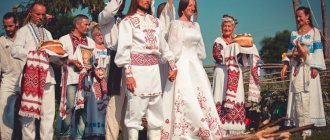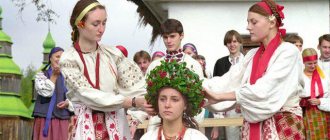Armenians are an ancient people with their own cultural history and rich in traditions. They have been protecting them for several centuries, and many of them have survived to this day. One of the most ancient customs of the Armenians is to marry off a bride according to all the rules of their people. This custom has many nuances, for example, the ransom of the bride, her wedding attire, and the ceremony. But the first wedding night among Armenians is especially important. Since this is a matter of honor not only for the bride, but also for her parents and the entire family.
How did Armenian matchmaking work?
Matchmaking among Armenians is a tradition. But not all of them have survived to this day.
However, in ancient times it looked like this:
- The bride was chosen by the groom's parents. The young man and girl were not given the right to choose a spouse.
- The first meeting of the bride's parents took place with one of the groom's relatives. The latter agreed on the date of arrival of the matchmakers.
- A relative of the groom, well known to both families, came to the first matchmaking ceremony. The bride's family greeted him with family warmth and respect. But according to tradition, they refused to marry off the bride.
- Many relatives from the bride and groom’s side gathered for the second matchmaking. Since the second meeting was more significant, there were more treats. The groom's relatives were greeted with all honors and tried to show how much they appreciated their arrival. At this meeting, the bride's parents agreed to the union of the children.
KNOWLEDGE BASE: Unusual DIY wedding gifts
No red apples
About 30% of first sexual intercourse in women is not accompanied by bleeding, gynecologists note. This is explained by the physiology of the hymen (the so-called hymen). However, tradition demands: blood on the sheet is obligatory.
In Armenia, there were cases when the bride was returned to her parents' house because the sheet was clean on the wedding night. One of these cases occurred in the city of Martuni, Gegharkunik region, several years ago. Karina was then working as a nurse in a hospital, where a young girl was brought for a “check.”
“There was a terrible scream in the department. As it turned out, a young girl was brought to a gynecologist for a check-up to find out why she didn’t have any blood after her wedding night,” says Karina.
She recognized this girl as her relative, who came to the hospital accompanied by her husband, mother-in-law and sister-in-law. New relatives accused the girl of “dishonesty” right in the corridor.
“Later I found out that the whole problem was in the anatomical location of the hymen. However, the relationship of the young family was already damaged. Coming out of the gynecologist's office, the girl hit her husband in the face right in the corridor and told his relatives that she was leaving them. Now she is a happy wife - she got married for the second time, but no one knows what happened to that guy and his family. They left,” says Karina.
Wedding customs among Armenians
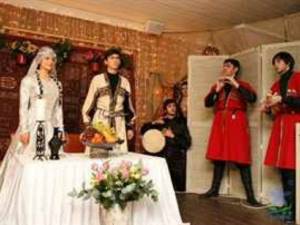
Armenia is rich in its traditions and customs. The Union of the Young was an important event for everyone and therefore took place according to certain rules established from time immemorial.
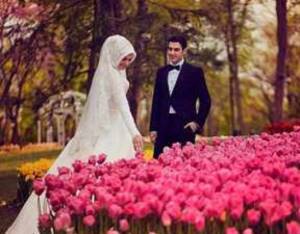
And here are a few of them:
- The first wedding night took place in the groom's house;
- On the first night, a man remained at the door of the newlyweds’ room to notify the groom’s parents about the bride’s chastity;
- Before the wedding night, the girl had to hug several of the groom's relatives. And she started with a little boy, so that many children would be born in the marriage;
- Only after the bride and groom are alone in the room will they be considered husband and wife;
- Many people think that Armenians practice Islam, but this is not so. Armenians profess Christianity, and the wedding ceremony takes place according to Christian customs. Of course, some traditions are very different from Russian ones, but the essence remains the same;
- During the wedding ceremony, it is forbidden to shout “bitterly”, and the bride and groom are forbidden to hug and kiss until the first night of marriage;
- All wedding expenses are paid by the husband and his family;
- Traditionally, the bride cannot choose her wedding dress herself. It is chosen by the groom and presented to her as a gift;
- Armenian wedding dresses are practically no different from everyday ones. The only difference is the decoration of the dress; it can be embroidered with gold, silver and jewelry;
KNOWLEDGE BASE: The official part of the wedding - how to conduct

- Also, the bride does not eat, drink, talk or dance during the celebration, only at the end the girl is allowed to dance one dance, but only after the permission of the elder;
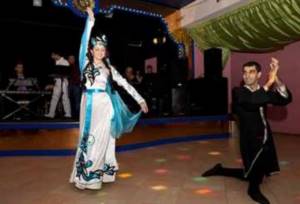
- The wedding celebration can last up to a week, unlike Russians, which last two days.
Armenian wedding traditions
Due to the fact that I myself recently attended an Armenian-Russian wedding as a bride, and am actually familiar with the traditions and customs of traditional Armenian weddings, I took the liberty of describing everything I know on this issue in this report. I would like to note that the official birth of our family took place in two stages. The first is registering a marriage before government authorities in the registry office of the city of Moscow. The second is a wedding in the Armenian church in the city of Armavir and a ceremonial feast with invited guests in a restaurant.
Since my husband is Russian, our celebration included, in addition to Armenian, Russian customs. Such as welcoming the newlyweds with a loaf of salt, breaking plates before entering the room, etc. But many of the Armenian rituals are similar to Russian ones.
So, for example, in Russia, traditionally, the groom’s mother greets the newlyweds with bread and salt and parting words, and after the newlyweds, the rest of the guests, before entering the house, are required to break off a piece of bread, dip it in salt and eat it. According to Armenian tradition, the mother of the bride places lavash on both shoulders of each of the newlyweds. In addition, it is customary for Armenians to treat young people with a spoonful of honey as a wish for a sweet life. Thus, both bread procedures symbolize the parents’ wishes for prosperity and well-being for the young family. We were greeted by the parents on the groom’s side with a loaf of salt and on the bride’s side with pita bread and honey.
At the newlyweds' table, the godfather (kavor) and mother (kavor kin) are usually seated on the right side, and the unmarried girl (harsnakuir) and the unmarried guy (azabbashi) on the left side of the young couple. Cavor is often appointed toastmaster. At the same time, a kavor in an Armenian family is the best man at the wedding, the godfather at the wedding, and then the godfather of all future children of the newlyweds. But, unlike Russian Orthodox traditions, where the godfather and godmother should not be officially married, this is allowed in the Armenian Church. So, our godparents at the wedding were the spouses who were godparents at my baptism.
In old Armenian traditions, before the wedding, the parties discussed the number of “makars” (delegates) who would follow the bride. Makars surrounded the groom as bodyguards and protected him from any surprises. In the context of the historical encirclement of Armenians by Turks, Kurds and other hostile tribes, there was a great danger of theft of Armenian girls, so Makars are rather courageous armed young guys (20-50 people), whose task was the safety of the entire wedding procession.
The procession of Makarov approached the bride's house with loud music, exclamations and noise; young people from among the guests from the bride's side also greeted them with noisy fun. Over time, the need for armed strong makaras disappeared, but the tradition of a noisy procession to the bride’s house remained.
On the day of the celebration, women from the groom’s close relatives dance in a noisy crowd in front of the bride’s house or in the yard. They present "sini" - trays with gifts to the bride. One tray contains the bride’s wedding dress with all accessories, another contains gifts for the father, mother and all other family members, and the third contains gourmet drinks, fruits and sweets. They dance with these trays until the bride’s close women and girls take it from their hands and present symbolic small gifts in return. The mother of the bride will then fill these blues with gifts and send them back to the mother of the groom.
According to ancient beliefs, a wedding dress is traditionally given by the parents of the future husband. The bride is dressed in everything that was brought to her on trays - blue. When the bride, her brother or another close relative is taken out of the house, (a teenage boy) at the gate blocks the path for the young people and does not want to let his sister go. Then Kavor gives him a symbolic ransom. At our celebration, the first part of the songs and dances was omitted, but a school-age cousin insisted on ransom, holding the door with a dagger, and let everyone out of the house only after a generous monetary reward from his godfather.
An Armenian wedding is celebrated on a grand scale, and all relatives and friends participate in it. Usually, all close and distant relatives, friends, friends of relatives and simply few people they know are invited to the wedding. In some villages, absolutely all village residents can take part in the celebration. Thus, the most modest wedding by Armenian standards consists of 50-100 people. At my parents' wedding, about 300 guests took part and they were accommodated in tents stretched right on the roadway. Our wedding was very modest, since only 50 relatives were invited to it.
The Sacrament of Marriage is performed by the Church and is the closest union ever concluded that two people can establish. In Russia, a wedding is perceived as a serious step, and not everyone is ready to take it. While in Armenia the registry office is given a secondary place and the marriage is considered concluded only after the wedding in the church. The wedding procedure itself is very similar to the Orthodox one. The sacrament of the wedding begins from the moment when the bride and groom enter the temple and stand in the center of the hall. Kharsnakuir and azabbashi usually stand in front of them with lit candles, and the godfather and his wife stand behind the couple. To the right of the priest should stand the groom with his godparents, and on the left hand should be the bride with the harsnakuir and azabbashi.
Usually the wedding ceremony begins with the reading of the Lord's Prayer in Armenian. After this, the priest himself, together with the choir, sings a series of prayers, according to the canon corresponding to the wedding ceremony. After this, the moment comes for the second exchange of rings, but with the participation of a priest. To do this, he takes the rings from the young people, sanctifies them, and then helps them put them on. It should also be taken into account that newlyweds put both engagement and wedding rings on the index finger of the left hand (in Russia - the right). Therefore, after the registry office we wore rings on the right hand, after the wedding - on the left, and in Georgia we already returned them to the right hand (as in Russia, in Georgia rings are worn on the right hand).
When the rings are put on, the priest joins the hands of the newlyweds, placing the bride's right palm into the groom's right palm. What follows is the climax of the wedding. The priest asks the groom a question: “My son, are you ready to be the head of the family and take care of your wife for the rest of your life?” The question to the bride sounds a little different: “My daughter, are you ready to be submissive to your husband for the rest of your life?” If both the bride and groom give positive answers, then the marriage has taken place. The difference in questions to the bride and groom reflects the traditional, patriarchal ideas of the Armenian family. The man is the head of the family, which is emphasized by the wedding ceremony. Now a man and a woman in an Armenian family have completely equal rights and many modern Armenian women successfully work and do business, but still the traditional ideas about family harmony among Armenians are preserved.
After the conclusion of the marriage, the priest and choir perform the spiritual chant “Ura Ler Surb Yegehetsi” (Hail, Holy Church). Next, a prayer is read in which the priest asks the Lord to bless the new marriage. The priest reads, blesses the young people and passes the cross into the hands of the godfather, who must hold it over the heads of the young people. Then the priest puts golden crowns on the heads of the bride and groom, which they should touch, bowing their heads. All these actions symbolize the condescension of grace on the young and their receipt of blessings for their entire future life together.
At the end of the ceremony, the newlyweds are presented with a glass of wine. They drink wine from the same glass. The most touching procedure of the wedding ceremony begins: the young couple, standing on the pulpit, at the altar, accepts congratulations from family and friends. After the wedding is completed, the newlyweds usually light candles near an icon and, together with relatives and friends, leave the temple to celebrate the wedding.
After releasing the pigeons and a short photo session held in the central park of the city next to the church, we headed to a restaurant located in close proximity to the church and the park, where guests were already waiting for us. The entire scenario of the restaurant celebration with a joint duet of the newlyweds, a wedding waltz and so on was compiled by me in accordance with the celebration practices accepted in Armenia and Russia. Among the distinctive Armenian features are the theft of the bride's shoes and tarosiki.
Armenian tarosiki are small beautiful souvenirs - baskets, bags, boxes with sweets and dragees. The meaning is that a piece of the love sweetness of the newlyweds is hidden in the tarosik. Typically, tarosiki should contain an odd number of sweets, since it is associated with a single indivisible whole of the newly formed family.
The word tarosik was formed as a diminutive from the Armenian word “taros”. They usually say: “tarosa kez”, which translates as “I pass it on to you.” Tarosiki are used at weddings and christenings, and these holidays are one of the most important and happiest events in the life of every person. The Armenian people are very kind and hospitable, so it was decided in the distant past to convey a piece of their happiness to the guests sharing a joyful event with you, in the form of tarosik.
Most often, tarosiki are given to unmarried girls after throwing the bride's bouquet. The girl who received the tarosik must eat sweets before going to bed, and place the tarosik itself under the pillow. According to legend, on the first wedding night of the newlyweds, the girl who has done this will see her betrothed in a dream.
In addition, at an Armenian wedding it is customary to generously thank the musicians, since not a single wedding takes place without fiery dancing until you drop. The guests donate the money intended for the musicians, not to them themselves, but to the dancing couple. While the dance lasts, the dancer (in this case, the bride and groom and usually even just one bride) places banknotes between their fingers. At the end of the dance, she must give these bills to the musicians. By the way, this form of gratitude to musicians still exists today. In our case, and in many cities, live music no longer plays; a certain amount is agreed upon with the DJ, and the newlyweds keep the money collected at the wedding for themselves.
In the old days, the mother of the bride was supposed to stay at home and not take part in the wedding feast, but now this tradition has become obsolete. The wedding feast continues until late at night, after which the guests disperse and only close relatives remain.
In traditional patriarchal Armenian families, the ritual of confirming the innocence of the future wife remains and is observed. After the first wedding night, a messenger is sent to the home of the honest and responsible bride with a red apple praising her parents. But now this tradition has already become obsolete, despite the fact that the cult of virginity is still active in Armenia.
Armenians' first wedding night
This is a huge event for the bride and groom, and besides them, for the entire village. On this night, the newlyweds become husband and wife. It was important to everyone whether the bride maintained chastity on her wedding night or not. If the bride did not maintain her dignity, then it was a terrible shame for her and her entire family. The groom's parents, having learned about this, sent the bride home with condemnation and insults. And the marriage was considered dissolved. But such unpleasant incidents occurred very rarely. An Armenian girl from birth is brought up according to the traditions and moral norms of Armenia. Caucasian girls are considered a model of modesty and chastity throughout the world.
There used to be a “Red Apple” tradition, after the first wedding night, the mother-in-law would hang a sheet with a bloody stain in the yard as proof that the girl was a virgin at the time of intercourse. Any passerby or resident of the village could look at this sheet and also make sure of this.
KNOWLEDGE BASE: 5 fresh ideas on how to propose marriage in an original way
If all the canons were followed and the girl was truly pure, then she was given a red apple with silver coins. And her mother was sent a large basket with red apples, a bottle of cognac or wine and a live chicken - as a sign that the mother raised her daughter correctly.
Otherwise, if the bride was defamed even before marriage, she was placed, backwards, on a donkey. And they sent us for a ride along the main street. So that everyone can see and know about the girl’s unworthy behavior.
In the end, we can conclude that Armenia is a proud nation. Which honors and respects the traditions of its ancestors. He is also very sensitive to his honor and dignity. Armenian women are role models, a standard of modesty, decency and chastity.
"Institute of Virginity"
“It’s a terrible tradition, and I have a very bad attitude towards it. I don’t know how it is there from a cultural point of view, but from the perspective of life in a progressive society, there shouldn’t be a “red apple,” says Hakob.
Hakob has been married for several years. His story is not entirely typical for Armenia, since before the wedding he and his future wife had sex. In Armenia, it is still customary for a girl not to have sexual intercourse before marriage, and premarital sex is considered something shameful.
“The institution of virginity is still important in Armenia. Our people are very proud. For men, it’s downright unacceptable that there was someone else before you. For many guys, it’s even a problem if the girl was dating someone,” says Hakob.
In Yerevan, the tradition of the “red apple” is now almost not observed. In the regions the situation is different.
Sarkis grew up in a traditional Armenian family in the Gegharkunik region - 130 kilometers from the capital. He moved to Yerevan at the age of 18. Here he received a higher education and decided not to return to the village. Unless you have a wedding there.
The morning after the wedding, his mother did not go into the newlyweds’ bedroom; she only asked her son if “everything was okay.” Having received a positive answer, she began to prepare the basket.
According to tradition, those same red apples are placed in the basket, symbolizing traces of blood on the sheet, cognac, sweets and fruits. The basket is taken to the bride's house by the groom's exclusively female relatives. Men do not take part in this.
“Our mothers agreed in advance how many people from our side would go to visit the bride’s family, since her mother was supposed to give gifts,” says Sarkis.
By noon, all the neighbors, as well as aunts and sisters, had already gathered in his house. “In our area, all the women my mother interacted with were invited. And everyone came. This is a kind of opportunity to boast of the purity of the son’s chosen one. The same composition was assembled in the bride’s house when baskets were brought there from us.”
Despite the fact that Sarkis decided to observe the “apple tradition,” he calls this ceremony meaningless: “If a couple loves and respects each other, then it should not concern the others whether they had sex before the wedding or not. For most people, sex happens for the first time on their wedding night - for the bride this is already tension and excitement, and then there is also a test in the morning.”
Sarkis explains the observance of tradition by the fact that the wedding took place in the village.
“If the wedding had been in the city, our parents would have simply called and discussed everything over the phone. But since everything happened in the village, one could say that everyone there is just waiting for this - the results of the “check”. And if the results are not announced, it will become a reason for gossip. This tradition puts young people in an awkward position. At this point it becomes embarrassing,” he says.
In Armenia, newlyweds very often prefer to spend their first wedding night in some hotel in the city of Tsakhkadzor. This is one of the main resort cities in the country. As a rule, a cottage or room is rented there, which is decorated for the arrival of the newlyweds. The couple spends one or two days there.
“I didn’t leave because people might think that we had our wedding night before the wedding, and we don’t want them to know about it. To avoid these conversations, I had to stay,” notes Sarkis.






